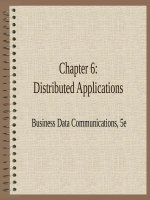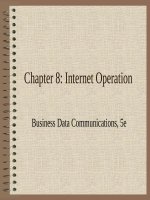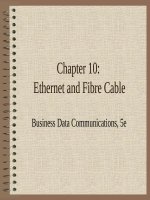Business data communications 5e by stallings chapter 16
Bạn đang xem bản rút gọn của tài liệu. Xem và tải ngay bản đầy đủ của tài liệu tại đây (183.63 KB, 41 trang )
Chapter 16:
Data Communication
Fundamentals
Business Data Communications, 5e
Data Communication
Components
• Data
– Analog: Continuous value data (sound, light,
temperature)
– Digital: Discrete value (text, integers, symbols)
• Signal
– Analog: Continuously varying electromagnetic wave
– Digital: Series of voltage pulses (square wave)
• Transmission
– Analog: Works the same for analog or digital signals
– Digital: Used only with digital signals
Business Data Commun
ications, 5e
2
Analog Data→Signal Options
• Analog data to analog signal
– Inexpensive, easy conversion (eg telephone)
– Data may be shifted to a different part of the
available spectrum (multiplexing)
– Used in traditional analog telephony
• Analog data to digital signal
– Requires a codec (encoder/decoder)
– Allows use of digital telephony, voice mail
Business Data Commun
ications, 5e
3
Digital Data→Signal Options
• Digital data to analog signal
– Requires modem (modulator/demodulator)
– Allows use of PSTN to send data
– Necessary when analog transmission is used
• Digital data to digital signal
– Requires CSU/DSU (channel service unit/data service
unit)
– Less expensive when large amounts of data are
involved
– More reliable because no conversion is involved
Business Data Commun
ications, 5e
4
Transmission Choices
• Analog transmission
– only transmits analog signals, without regard for data
content
– attenuation overcome with amplifiers
– signal is not evaluated or regenerated
• Digital transmission
– transmits analog or digital signals
– uses repeaters rather than amplifiers
– switching equipment evaluates and regenerates signal
Business Data Commun
ications, 5e
5
Data, Signal, and
Transmission Matrix
A
Data
D
D
A
A
D
Transmission
System
Signal
Business Data Commun
ications, 5e
6
Advantages of Digital
Transmission
•
•
•
•
The signal is exact
Signals can be checked for errors
Noise/interference are easily filtered out
A variety of services can be offered over
one line
• Higher bandwidth is possible with data
compression
Business Data Commun
ications, 5e
7
Why Use Analog Transmission?
•
•
•
•
Already in place
Significantly less expensive
Lower attenuation rates
Fully sufficient for transmission of voice
signals
Business Data Commun
ications, 5e
8
Analog Encoding
of Digital Data
• Data encoding and decoding technique to
represent data using the properties of
analog waves
• Modulation: the conversion of digital
signals to analog form
• Demodulation: the conversion of analog
data signals back to digital form
Business Data Commun
ications, 5e
9
Modem
• An acronym for modulator-demodulator
• Uses a constant-frequency signal known as
a carrier signal
• Converts a series of binary voltage pulses
into an analog signal by modulating the
carrier signal
• The receiving modem translates the analog
signal back into digital data
Business Data Commun
ications, 5e
10
Methods of Modulation
• Amplitude modulation (AM) or amplitude
shift keying (ASK)
• Frequency modulation (FM) or frequency
shift keying (FSK)
• Phase modulation or phase shift keying
(PSK)
Business Data Commun
ications, 5e
11
Amplitude Shift Keying (ASK)
• In radio transmission, known as amplitude
modulation (AM)
• The amplitude (or height) of the sine wave
varies to transmit the ones and zeros
• Major disadvantage is that telephone lines
are very susceptible to variations in
transmission quality that can affect
amplitude
Business Data Commun
ications, 5e
12
ASK Illustration
1
0
0
Business Data Commun
ications, 5e
1
13
Frequency Shift Keying (FSK)
• In radio transmission, known as frequency
modulation (FM)
• Frequency of the carrier wave varies in
accordance with the signal to be sent
• Signal transmitted at constant amplitude
• More resistant to noise than ASK
• Less attractive because it requires more
analog bandwidth than ASK
Business Data Commun
ications, 5e
14
FSK Illustration
1
1
0
Business Data Commun
ications, 5e
1
15
Phase Shift Keying (PSK)
• Also known as phase modulation (PM)
• Frequency and amplitude of the carrier
signal are kept constant
• The carrier signal is shifted in phase
according to the input data stream
• Each phase can have a constant value, or
value can be based on whether or not phase
changes (differential keying)
Business Data Commun
ications, 5e
16
PSK Illustration
0
0
1
Business Data Commun
ications, 5e
1
17
Differential Phase Shift Keying
(DPSK)
0
1
1
Business Data Commun
ications, 5e
0
18
Voice Grade Modems
QuickTime™ and a
TIFF (LZW) decompressor
are needed to see this picture.
Business Data Commun
ications, 5e
19
Cable Modems
• Permits Internet access over cable television networks.
• ISP is at or linked by high-speed line to central cable
office
• Cables used for television delivery can also be used to
deliver data between subscriber and central location
• Upstream and downstream channels are shared among
multiple subscribers, time-division multiplexing
technique (see Chapter 17)
• Splitter is used to direct TV signals to a TV and the data
channel to a cable modem
Business Data Commun
ications, 5e
20
Cable Modem Layout
Business Data Commun
ications, 5e
21
Asymmetric Digital
Subscriber Line (ADSL)
•
•
•
•
New modem technology for high-speed digital transmission over
ordinary telephone wire.
Telephone central office can provide support for a number of ISPs,
At central office, a combined data/voice signal is transmitted over a
subscriber line
At subscriber’s site, twisted pair is split and routed to both a PC and
a telephone
– At the PC, an ADSL modem demodulates the data signal for the PC.
– At the telephone, a microfilter passes the 4-kHz voice signal.
•
The data and voice signals are combined on the twisted pair line
using frequency-division-multiplexing techniques (Chapter 17)
Business Data Commun
ications, 5e
22
DSL Modem Layout
Business Data Commun
ications, 5e
23
Digital Encoding
of Analog Data
• Evolution of telecommunications networks to digital
transmission and switching requires voice data in digital form
• Best-known technique for voice digitization is pulse-code
modulation (PCM)
• The sampling theorem: If a signal is sampled at regular
intervals of time and at a rate higher than twice the significant
signal frequency, the samples contain all the information of
the original signal.
• Good-quality voice transmission can be achieved with a data
rate of 8 kbps
• Some videoconference products support data rates as low as
64 kbps
Business Data Commun
ications, 5e
24
Converting Samples to Bits
• Quantizing
• Similar concept to pixelization
• Breaks wave into pieces, assigns a value in
a particular range
• 8-bit range allows for 256 possible sample
levels
• More bits means greater detail, fewer bits
means less detail
Business Data Commun
ications, 5e
25









